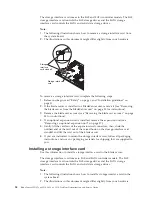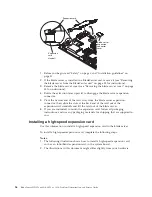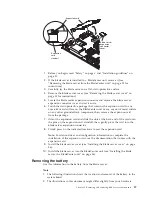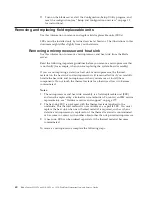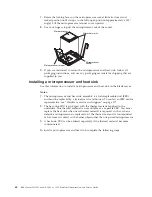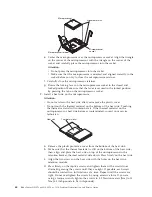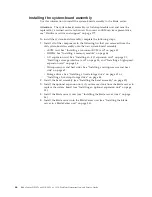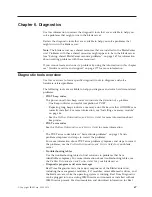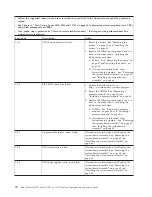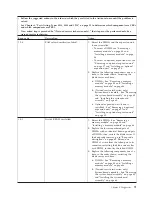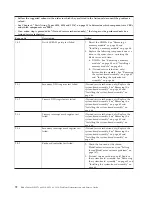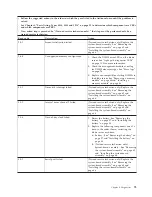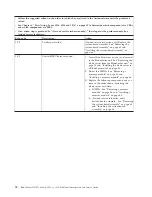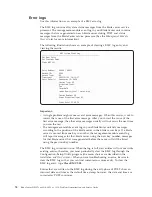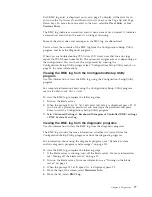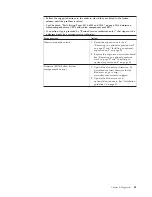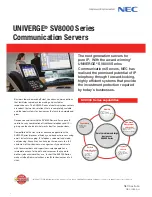
Time Diagnostics, see http://www.ibm.com/systems/management/. For more
information about diagnostic programs and error messages, see the
Problem
Determination and Service Guide
for your blade server.
The IBM Dynamic System Analysis (DSA) diagnostic programs are the primary
method of testing the major components of the blade server. The diagnostic
programs are available in the preboot environment by pressing F2 during the
boot process. The Preboot DSA diagnostic programs are stored in integrated USB
memory and collect and analyze system information to aid in diagnosing blade
server problems. The diagnostic programs collect the following information
about the blade server:
– System configuration
– Network interfaces and settings
– Installed hardware
– Light path diagnostics status
– Vital product data, firmware, and BIOS configuration
– Storage drive health
– Baseboard Management Controller logs
The diagnostic programs create a merged log that includes events from all
collected logs. The information is collected into a file that you can send to the
IBM Support Center. Additionally, you can view the blade server information
locally through a generated text report file. You can also copy the log to
removable media and view the log from a Web browser.
Note:
If you are unable to find the system-error logs in the blade server
firmware code, view the system-event log in the BladeCenter management
module.
v
Light path diagnostics
Use light path diagnostics LEDs on the system board to diagnose system errors.
If the system-error LED on the system LED panel on the front or rear of the
BladeCenter unit is lit, one or more error LEDs on the BladeCenter unit
components also might be lit. These LEDs help identify the cause of the
problem. Blade server error LEDs are described in the
Problem Determination and
Service Guide
for your blade server.
POST
Use this information for more about POST self-test errors for the blade server.
When you turn on the blade server, it performs a series of tests to check the
operation of the blade server components and some optional devices in the blade
server. This series of tests is called the power-on self-test, or POST.
1.
If a power-on password is set, you must type the password and press Enter,
when you are prompted, for POST to run.
2.
If POST is completed without detecting any problems, a single beep sounds,
and the blade server startup is completed.
3.
If POST detects a problem, more than one beep might sound, or an error
message is displayed. See “Beep code descriptions” on page 69 and “POST
error codes” on page 86 for more information.
POST beep codes
Use this information to diagnose and resolve POST beep code errors.
68
BladeCenter HS12 Type 8014, 8028 or 1916: Problem Determination and Service Guide
Summary of Contents for BladeCenter HS12 Type 1916
Page 1: ...BladeCenter HS12 Type 8014 8028 or 1916 Problem Determination and Service Guide...
Page 2: ......
Page 3: ...BladeCenter HS12 Type 8014 8028 or 1916 Problem Determination and Service Guide...
Page 36: ...24 BladeCenter HS12 Type 8014 8028 or 1916 Problem Determination and Service Guide...
Page 186: ...174 BladeCenter HS12 Type 8014 8028 or 1916 Problem Determination and Service Guide...
Page 190: ...178 BladeCenter HS12 Type 8014 8028 or 1916 Problem Determination and Service Guide...
Page 198: ...186 BladeCenter HS12 Type 8014 8028 or 1916 Problem Determination and Service Guide...
Page 203: ......
Page 204: ...Part Number 60Y1601 Printed in USA 1P P N 60Y1601...

